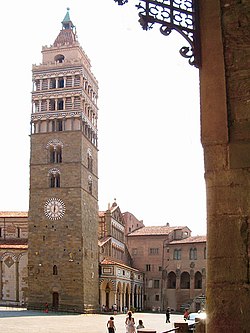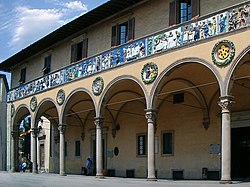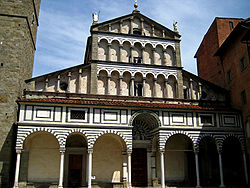Pistoia
Pistoia | |
|---|---|
| Città di Pistoia | |
 The bell tower of the cathedral in Piazza Duomo | |
 Coat of arms | |
 Pistoia within the Province of Pistoia | |
show Location of Pistoia | |
 Pistoia Location of Pistoia in Italy | |
| Coordinates: 43°56′N 10°55′E / 43.933°N 10.917°ECoordinates: 43°56′N 10°55′E / 43.933°N 10.917°E | |
| Country | Italy |
| Region | Tuscany |
| Province | Pistoia (PT) |
| Frazioni | see list |
| Government | |
| • Mayor | Alessandro Tomasi |
| Area | |
| • Total | 236.17 km2 (91.19 sq mi) |
| Elevation | 65 m (213 ft) |
| Population (31 August 2016)[2] | |
| • Total | 90,363 |
| • Density | 380/km2 (990/sq mi) |
| Demonym(s) | Pistoiese (singular), Pistoiesi (plural) |
| Time zone | UTC+1 (CET) |
| • Summer (DST) | UTC+2 (CEST) |
| Postal code | 51100 |
| Dialing code | 0573 |
| Patron saint | St. Jacopo |
| Saint day | July 25 |
| Website | Official website |




Pistoia (US: /pɪˈstɔɪə, piːˈstoʊjɑː/,[3][4] Italian: [pisˈtoːja] (![]() listen)[5] is a city and comune in the Italian region of Tuscany, the capital of a province of the same name, located about 30 kilometres (19 mi) west and north of Florence and is crossed by the Ombrone Pistoiese, a tributary of the River Arno. It is a typical Italian medieval city, and it attracts many tourists, especially in the summer. The city is famous throughout Europe for its plant nurseries.
listen)[5] is a city and comune in the Italian region of Tuscany, the capital of a province of the same name, located about 30 kilometres (19 mi) west and north of Florence and is crossed by the Ombrone Pistoiese, a tributary of the River Arno. It is a typical Italian medieval city, and it attracts many tourists, especially in the summer. The city is famous throughout Europe for its plant nurseries.
History[]
Pistoria (in Latin other possible forms are Pistorium or Pistoriae) was a centre of Gallic, Ligurian and Etruscan settlements before becoming a Roman colony in the 6th century BC, along the important road Via Cassia: in 62 BC the demagogue Catiline and his fellow conspirators were slain nearby. From the 5th century the city was a bishopric, and during the Lombardic kingdom it was a royal city and had several privileges. Pistoia's most splendid age began in 1177 when it proclaimed itself a free commune: in the following years it became an important political centre, erecting walls and several public and religious buildings.
In 1254 the Ghibelline town of Pistoia was conquered by the Guelph Florence; this did not pacify the town, but led to marked civil violence between "Black" and "White" Guelph factions, pitting different noble families against one another. In the Inferno of Dante, we encounter a particularly violent member of the Black faction of Pistoia, Vanni Fucci, tangled up in a knot of snakes while cursing God, who states: (I am a) beast and Pistoia my worthy lair. Pistoia remained a Florentine holding except for a brief period in the 14th century, when a former abbott, Ormanno Tedici, became Lord of the city. This did not last long, since his nephew Filippo sold the town to Castruccio Castracani of Lucca. The town was officially annexed to Florence in 1530.
One of the most famous families of the city was that of the Rospigliosi, owners of agricultural estates and wool merchants; the Rospigliosi provided a pope in 1667 with Giulio Rospigliosi, who briefly reigned as Clement IX (1667–69), and gave several cardinals to the church.
In 1786 a famous Jansenist episcopal synod was convened in Pistoia.
According to one theory, Pistoia lent its name to the pistol,[6] which started to be manufactured in Pistoia during the 16th century. But today, it is also notable for the extensive plant nurseries spreading around it. Consequently, Pistoia is also famous for its flower markets, as is the nearby Pescia.
Geography[]
Pistoia borders with the municipalities of Agliana, Alto Reno Terme, Cantagallo, Lizzano in Belvedere, Marliana, Montale, Quarrata, Sambuca Pistoiese, San Marcello Piteglio and Serravalle Pistoiese.[7]
Frazioni (Districts)[]
| hideName | Population |
|---|---|
| Sant'Agostino | |
| Sant'Alessio in Bigiano | |
| Badia a Pacciana | |
| Baggio | |
| Villa di Baggio | |
| Bargi | |
| Barile | |
| San Biagio | |
| Bonelle | |
| Bottegone | 6.000 |
| Campiglio | |
| Canapale | |
| Candeglia | |
| Capostrada | |
| Castagno di Piteccio | |
| Gello | |
| Germinaia | |
| Le Grazie | |
| Chiazzano | |
| Chiesina Montalese | |
| Chiodo | |
| Cignano | |
| Cireglio | |
| Collina | |
| Corsini Bianchi | |
| Corsini Neri | |
| Fabbrica | |
| San Felice | |
| Le Fornaci | |
| Lupicciano | |
| Masiano | |
| Casa Nuove di Masiano | |
| Masotti | |
| San Mommè | 177 |
| Nespolo | |
| Orsigna | |
| Piazza | |
| San Pierino Casa al Vescovo | |
| Piestro | |
| Piteccio | |
| Piuvica | |
| Pontelungo | |
| Pontenuovo | |
| Pracchia | 268 |
| Pupigliana | |
| San Rocco | |
| Santomato | |
| Saturnana | |
| Spazzavento | |
| Sazzana | |
| Torbecchia | |
| Valdibrana | |
| Villanova di Valdibrana | |
| Vicofaro |
Government[]
Architecture[]
Although less visited than other cities in Tuscany, the medieval city within Pistoia's old walls is charming and well-preserved.
Piazza del Duomo[]
The large Piazza del Duomo, dominated by the cathedral, is lined with other medieval buildings, such as the Palazzo del Comune and the Palazzo del Podestà: it is the setting (in July) of the Giostra dell'Orso ("Bear Joust"), when the best horsemen of the city's traditional quarters tilt with lances at a target held up by a dummy shaped like a bear.
The original Cathedral of San Zeno (5th century) burned down in 1108, but was rebuilt during the 12th century, and received incremental improvements until the 17th century. The façade has a prominent Romanesque style, while the interior received heavy Baroque additions which were removed during the 1960s. Its outstanding feature is the Altar of St James, an exemplar of the silversmith's craft begun in 1287 but not finished until the 15th century. Its various sections contain 628 figures, the total weighing nearly a ton. The Romanesque belfry, standing at some 67 metres (220 ft), was erected over an ancient Lombard tower.
In the square is also the 14th-century Baptistry, in Gothic style, with white and green striped marble revetment characteristic of the Tuscan Gothic.
The Palazzo dei Vescovi ("Bishops' Palace"), is characterized by a Gothic loggiato on the first floor. It is known from 1091, initially as a fortified noble residence. In the 12th century it received a more decorated appearance, with mullioned windows and frescoes, of which traces remain. It was later modified in the mid-12th century (when the St. James Chapel, mentioned by Dante Alighieri in the XXIV canto of his Inferno) and in the 13th century; to the latter restoration belongs the white marble-decorated staircase, one of the most ancient examples in Italy in civil architecture. In the 14th century, the Chapel of St. Nicholas was decorated with stories of the namesake saint and other martyrs.
The Tower of Catilina dates to the High Middle Ages, and stands 30 metres (98 ft) high.
Religious buildings[]
- Basilica of Our Lady of Humility (Madonna dell'Umiltà) (1509), finished by Giorgio Vasari with a 59-metre (194 ft) high cupola. The original project was by Giuliano da Sangallo, but works were begun in 1495 by . The dome was commissioned by Cosimo I de' Medici to Vasari, the lantern completed in 1568 and the church consecrated in 1582. In the apse is a painting by Bernardino del Signoraccio (1493).
- Santissima Annunziata, Baroque former church known for its Chiostro dei Morti ("Cloister of the Dead").
- San Bartolomeo in Pantano (12th century).
- San Giovanni Battista (15th century). Damaged during World War II bombardments, it is now used as an exhibition center.
- San Giovanni Battista al Tempio (11th century), owned for a while by the Knights Templar and then by the Hospitaller Knights.
- San Benedetto (14th century, restored in 1630). It houses an Annunciation (1390) by Giovanni di Bartolomeo Cristiani, a St Benedict with the Redeemer (16th-century) by Florentine painter, and in the cloister Histories of the Order of the Knights of St Benedict by Giovan Battista Vanni (1660).
- San Domenico.
- San Francesco (begun 1289). Franciscan church has an unfinished façade with bichrome marble decoration. It has frescoes with Histories of St. Francis in the main chapel and other 14th–15th century frescoes.
- San Giovanni Fuoricivitas (12th–14th century) Romanesque church
- San Leone (14th century) church enlarged in the 16th–18th centuries. Its Baroque-Roccoco interior houses some notable canvases by Giovanni Lanfranco, Stefano Marucelli and Vincenzo Meucci.
- Santa Maria delle Grazie, Pistoia
- Santa Maria in Ripalta (11th century) It houses a large Ascent of Christ fresco in the apse, attributed to Manfredino d'Alberto (1274).
- San Paolo.
- San Pier Maggiore.
- Pieve di Sant'Andrea, housing Giovanni Pisano's Pulpit of St. Andrew.
- , ancient chapel now parish church.
- La Vergine.
Others[]
- The 14th-century walls. These had originally four gates, Porta al Borgo, Porta San Marco, Porta Carratica and Porta Lucchese, all demolished at the beginning of the 20th century.
- Ospedale del Ceppo (13th century).
- Palazzo Panciatichi
- Medici Fortress of Santa Barbara, built at first in 1331 by the Florentines, but destroyed by the Pistoiese citizens in 1343. It was rebuilt by order of Cosimo I de' Medici from 1539, and later enlarged by Bernardo Buontalenti. It sustained one single siege by the Barberini troops in 1643, before being disarmed by Grand Duke Peter Leopold in 1734. Later it was used as a barracks and military jail, while today it serves as a venue for cinema shows during the summer.
- Accademia dei Risvegliati
- Palazzo Rospigliosi, Pistoia
- Monument in Honour of Brazilians (Soldiers and Pilots) killed in action during Italian Campaign of World War II
- Brazilian Military Cemetery of Pistoia
Transportation[]
The railway station is located on the Viareggio–Florence railway and it is at the southern end of the Porrettana railway, the original line between Florence and Bologna.
Culture[]
Cinema[]
Pistoia has been a setting for numerous works of fiction and movies, including films, such as I Love You in All the Languages in the World, Amici miei, and Medici: Masters of Florence.
Music[]
Notable residents[]
International relations[]
Twin towns - sister cities[]
Pistoia is twinned with:[8]
Events[]
- Pistoia Blues, an international music festival held since 1980. It is one of the most important European blues festivals. Artists such as B.B. King,[9] Bob Dylan and David Bowie have attended and performed at the festival.
- Giostra dell'Orso ("Joust of the Bear"), a ceremony that is mentioned even in a chronicle dating back to 1300, when a dozen riders organized a ritual combat against a bear. Despite many changes, this traditional ceremony was staged every year until 1666, when the abandonment was recorded by the ritual celebration of the people. It was restarted in 1947, and takes place on July 25.
See also[]
References[]
- ^ "Superficie di Comuni Province e Regioni italiane al 9 ottobre 2011". Istat. Retrieved 16 March 2019.
- ^ "Popolazione Residente al 1° Gennaio 2018". Istat. Retrieved 16 March 2019.
- ^ "Pistoia". The American Heritage Dictionary of the English Language (5th ed.). Boston: Houghton Mifflin Harcourt. Retrieved 20 May 2019.
- ^ "Pistoia". Merriam-Webster Dictionary. Retrieved 20 May 2019.
- ^ Canepari, Luciano. "Dizionario di pronuncia italiana online" (in Italian). Retrieved 1 May 2015.
- ^ Online Etymology Dictionary
- ^ 42722 Pistoia on OpenStreetMap
- ^ "Pistoia". italien.de (in German). Italien.de. Retrieved 2019-12-22.
- ^ "Pistoia Blues" on lonelyplanet.com
Sources[]
- David Herlihy. Medieval and Renaissance Pistoia: the social history of an Italian town. New Haven and London, Yale University Press, 1967.
External links[]
| Wikimedia Commons has media related to Pistoia. |
- Cities and towns in Tuscany
- Municipalities of the Province of Pistoia
- Pistoia
- Cities founded by Rome



